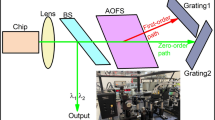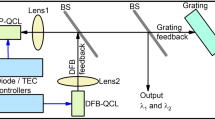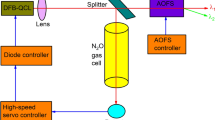Abstract
Tunable double-mode external cavity (EC) quantum cascade lasers (QCLs) based on a dual-Littrow and a dual-Littman configuration are reported. An otherwise multi-mode emitted Fabry–Perot (FP) QCL with no anti-reflective facet coating is used as the gain chip. In the dual-Littrow setup, a widely course double-mode tuning range of 400 nm for the spectral range between 4450 and 4850 nm in pulsed operation is achieved by rotating the diffraction gratings, whereas in the dual-Littman configuration a course double-mode tuning range of 330 nm for the spectral range between 4460 and 4790 nm is reached by rotating the mirrors. In both cases, a fine continuous tuning range over 10 nm is reached by modulating the injection current in a few ms without moving any part. The linewidth and maximum optical power of the dual-Littrow setup are determined to be 0.08 cm−1 and 40 mW, whereas these values for the dual-Littman configuration are found to be 0.01 cm−1 and 35 mW, respectively. N2O is used as target molecule to evaluate the absorption features of the lasers. To the best of our knowledge, it is the first demonstration of such double-mode EC-QCLs.
Similar content being viewed by others
Avoid common mistakes on your manuscript.
1 Introduction
Analysis of trace gases in the mid-infrared (MIR) spectral region, which is known as the molecular fingerprint region, is important for a variety of industrial and scientific applications, such as industrial process control, non-invasive medical diagnostics, national security, and atmospheric and environmental sensing (Curl et al. 2010; Bayrakli 2017; Ravishankara et al. 2009; Fiddler et al. 2009) QCLs (Faist et al. 1994), which are unipolar semiconductor lasers based on intersubband transitions in multiple quantum wells, are ideal sources for this spectral region thanks to their broad gain bandwidth, compact size, and high output power (Schwaighofer et al. 2017).
It is desirable to detect several trace gases simultaneously using a single tunable multi-wavelength laser system instead of using two or more laser sources and their controllers/electronics because of its less energy consumption and compact structure. It is therefore valuable to design and develop wavelength-tunable dual-mode lasers. EC-QCLs provide wide and fast tunability across the QCL gain bandwidth and are very promising sources for this purpose (Zeninari et al. 2020). So far, single-mode EC-QCLs based on the Littrow or Littman/Metcalf configuration have been demonstrated by several groups (Maulini et al. 2006, 2005; Kruczek et al. 2013; Hoppe et al. 2019; Tan et al. 2013). Besides these grating-coupled lasers, acoustic-optical modulator (AOM)-controlled single-mode EC-QCLs have also been reported (Lyakh et al. 2015, 2016; Bayrakli 2022). Emission spectrum for the AOM tuned lasers differs from that for traditional external cavity diode lasers, because the laser beam experiences the Doppler shift equal to the sound wave frequency, when the beam propagates through the crystal. Therefore, these lasers have broader absorption lines (> 1–2 cm−1) that are not suitable for analyzing trace gas molecules. To date, no double-mode grating-coupled EC-QCL has been reported.
In this letter, tunable double-mode EC-QCLs based on a dual-Littrow and a dual-Littman configuration are reported. A multi-mode FP QCL without anti-reflection coating is used as the gain chip. Our work on tunable single-mode EC-QCLs utilizing the same chip used in the present study with acoustic-optic frequency shifter has recently been published (Bayrakli 2022). The performance of the system can be improved by using an AR-coated QCL, causing the price of the setup to increase. In the dual-Littrow setup, a widely course double-mode tuning range of 400 nm for the spectral range between 4450 and 4850 nm in pulsed operation is achieved by rotating the diffraction gratings. In the dual-Littman setup, a course double-mode tuning range of 330 nm for the spectral range between 4460 and 4790 nm is obtained by rotating the mirrors. In both cases, a fine continuous tuning range over 10 nm is reached by modulating the injection current. N2O is used as the target molecule to evaluate the absorption features of the lasers. The most important advantage of these setups is that they can analyze different samples with a single system. To the best of our knowledge, it is the first demonstration of such double-mode EC-QCLs.
2 Experimental setup
Figure 1a depicts the experimental setup based on a dual Littrow-type configuration. This setup consists of a gain chip, a lens, two beam splitters, and three diffraction gratings. A room-temperature pulsed FP QCL gain chip without AR coating (Thorlabs, QF4600T1-A037) is used as the gain medium. The QCL chip is installed in a thermo-electrically cooled mount (Thorlabs, LDM90/M) and is driven by a laser driver/TEC controller (Thorlabs, ITC 4002QCL) in pulsed mode (Duty cycle = 25%, pulse width = 25 ms). A 3-mm focal length aspheric lens (Thorlabs, C093TME-E) is utilized to collimate the laser radiation. A pellicle beam splitter (PBS) (Thorlabs, BP145B4) is inserted into the external cavity to split the laser beam into two parts, which are oriented to individual diffraction gratings (Thorlabs, GR2550-30035, 300 grooves/mm). The gratings are mounted on low-drift piezoelectric mounts (Thorlabs, POLARISK1PZ). The optical feedbacks are provided by the first orders of the diffracted beams. The selected modes are coupled back into the gain chip and are amplified. The grating angles are altered with respect to the incident beams for changing from one mode to another. The output is taken from another PBS. The modes are separated from each other using a diffraction grating.
Figure 1b shows the experimental setup based on a dual Littman-type configuration. This setup consists of a gain chip, a lens, two beam splitters, two gratings, and two mirrors. The diffracted beam is reflected back to the grating by the mirrors and diffracted again. Finally, the selected beams reach the gain chip and are amplified. Tuning is achieved by rotating the mirrors. The output is taken from another PBS. The modes are separated from each other using a diffraction grating.
The lasing wavelengths selected by the external cavities are measured with a monochromator (Newport Cornerstone 130 1/8 m, 200–5000 nm). To investigate the absorption abilities of the lasers, the spectra from a reference gas cell filled with N\(_2\)O (Wavelength References, Inc.) and an InAsSb amplified detector (Thorlabs, PDA07P2) are experimentally measured. The optical power is measured with a power meter (Thorlabs S302C, PM100D).
3 Results and discussion
3.1 Dual-Littrow setup
Figure 2 depicts the coarse double-mode tunable range of lasing wavelength in pulsed operation at different grating angles. The inset of the Fig. 2 shows the measured multi-mode emission spectrum of the FP-QCL (black line) and spectrum depicted from the Thorlabs data-sheet for comparison (red line). As shown in Fig. 2, the FP modes are suppressed completely. A manual coarse double—wavelength tuning range of 400 nm for the spectral range between 4450 and 4850 nm is obtained. The both modes with side mode suppression ratios (SMSRs) of > 40 dB can be tuned independently of each other. The intensities of the individual beams depend on the diffraction efficiencies of the gratings, the split ratios of the beam splitters, the optical alignment, and bandwidth of the gain chip.
Measured spectra from coarse grating tuning between 4450 and 4850 nm in a double-mode operation at different grating angles. The maximum wavelength difference between two modes is 400 nm. Inset: Measured multi-mode emission spectrum of the FP-QCL (without optical feedback from the diffraction gratings) (black line) and spectrum depicted from the Thorlabs data-sheet for comparison (red line). The resolution of the monochromator used is not sufficient to resolve FP modes
Output powers (P) as a function of injection current (I) for the FP- and EC-QCL at a given wavelength are shown in Fig. 3. The threshold current of the FP-QCL (\(I_{th -FP}\)) is found to be 490 mA. The maximum optical power achieved in the current setup is 118 mW. When the QCL chip is placed inside external cavities with grating 1 and 2, the current thresholds are reduced to 370 and 400 mA, while the maximum output powers decreased to 40 and 32 mW, respectively. The inset of the Fig. 3 depicts the laser output powers versus lasing wavelength for the EC-QCL with grating 1 and 2 at 480 mA (below \(I_{th-FP}\)). The highest average optical powers of 18 mW and 14 mW are achieved at 4620 nm for the grating 1 and 2, respectively. There is a double-mode operation area between the spectral range 4450 and 4850 nm. In the spectral ranges between 4850–4900 nm and 4400–4450 nm, tunable single-modes are obtained.
The spectra from the reference gas cell filled with N\(_2\)O are experimentally measured (Fig. 4) and compared with the theoretical calculation based on the HITRAN database (insets of the Fig. 4), to investigate the absorption feature of the laser and to estimate the laser linewidth. To evaluate the laser linewidth, the resolution of our monochromator is not sufficient. Modulating the injection current from 400 to 500 mA gives rise to a fast fine continuous wavelength tuning range over 10 nm in a few milliseconds without moving any part. The Fig. 4a shows the transmission signals with (blue line) and without (red line) the reference gas cell, measured from the grating 1 path. The peaks in the red lines are attributed to come from the water molecules in the ambient air. The Fig. 4b depicts the transmission signals, measured from the grating 2 path. The insets of the Fig. 4 show the absorption lines of N\(_2\)O calculated using the HITRAN database. For this simulation, the pressure of 66 mbar, the cell length of 20 cm, and the instrumental broadening of 0.08 cm\(^{-1}\) were taken. When the experimental and theoretical results are compared, we can see that the both results are in a good agreement. Therefore, we can estimate that each mode has a line width of around 0.08 cm\(^{-1}\).
3.2 Dual-Littman setup
The output power (P)–injection current (I) characteristics of the EC-QCL at a given wavelength are shown in Fig. 5. The threshold currents of the EC-QCL with mirror 1 and 2 setup are measured to be 400 and 440 mA, while the maximum output powers are determined to be 35 and 32 mW, respectively. The inset of the Fig. 5 shows the output powers as a function of lasing wavelength for the EC-QCL with mirror 1 and 2 at 480 mA. The highest average optical power of 13 mW and 8 mW reached at 4620 nm for the mirror 1 and 2, respectively. A manual coarse double-wavelength tuning range of 330 nm for the spectral range between 4460 and 4790 nm is obtained.
In order to investigate the absorption feature of the laser, the spectra from the reference gas cell filled with N\(_2\)O are measured (Fig. 6) and compared with the theoretical calculation based on the HITRAN database (insets of the Fig. 6). Modulating the injection current gives rise to a fast fine continuous wavelength tuning range over 10 nm in a few milliseconds without moving any part. The Fig. 6a shows the transmission signals with (blue line) and without (red line) the reference gas cell, measured from the mirror 1 path. The Fig. 6b depicts the transmission signals, measured from the mirror 2 path. The insets of the Fig. 6 show the absorption lines of N\(_2\)O calculated using the HITRAN database. For this simulation, the pressure of 66 mbar, the cell length of 20 cm, and the instrumental broadening of 0.01 cm\(^{-1}\) were taken. When the experimental and theoretical results are compared, we can see that the both results are in a good agreement. Therefore, we can estimate that each mode has a line width of around 0.01 cm\(^{-1}\).
For comparison of the dual-Littrow and dual-Littman setups, the results obtained are summarized in the Table 1. When we compare both setups, the advantage of the dual Littrow setup is that the optical feedback strength is strong and the alignment is easy. Therefore, this setup can produce more optical powers. The dual Littman configuration has an increased resolution (a better wavelength selectivity) because of the double pass of the beam on the grating. In the dual Littman arrangement, the tuning range is narrower compared to the dual Littrow setup. Considering all these situations, the dual Littrow setup can be used in applications where higher power is required, whereas the dual Littman configuration can be utilized in applications where higher resolution is desired. The QCL chip used in the present work operate in CW mode and can produce more power up to 700 mW. However, the TEC controller used does not permit the chip to work in CW mode due to insufficient heat dissipation. Wavelength tuning range and laser performance can be extended and improved when the laser is operated in CW mode with a suitable TEC mount.
4 Conclusion
Two EC-QCLs based on a dual Littrow-type and a dual Littman-type configuration without anti-reflection coating have been demonstrated. In the dual-Littrow setup, a widely course double-mode tuning range of 400 nm for the spectral range between 4450 and 4850 nm has been achieved by controlling the positions of the diffraction gratings. In the dual-Littman setup, a course double-mode tuning range of 330 nm for the spectral range between 4460 and 4790 nm has been obtained by controlling the positions of the mirrors. The linewidth and maximum optical power of the dual-Littrow setup have been found to be 0.08 cm\(^{-1}\) and 40 mW, whereas these values for the dual-Littman configuration have been measured to be 0.01 cm\(^{-1}\) and 35 mW, respectively.
The most important advantage of these setups is that they can analyze different samples with a single EC-QCL system simultaneously. In this way, a less energy-consuming and more compact molecule sensing system can be established, compared to other systems using multiple EC-QCLs and their electronics. The high-power dual-mode operation is also important for a wide range of other optical applications, such as dual-wavelength interferometry, THz (terahertz) wave generation and imaging, differential absorption light detection (DIAL), electromagnetically induced transparency (EIT), phase conjugation reflection (PCR), and nonlinear optics (four-wave mixing, sum and difference frequency generation). In the future works, a faster double-mode tuning speed in a broader spectral range will be investigated. Furthermore, we will work to obtain a high-power dual-mode EC-QCL. In this way, we want to study nonlinear optical phenomena in the QCLs.
References
Bayrakli, I.: Breath analysis using external cavity diode lasers: a review. J. Biomed. Opt. 22, 040901 (2017)
Bayrakli, I.: External cavity quantum cascade lasers without anti-reflection coating with intracavity and extracavity acoustic-optic frequency shifter for fast standoff detection. Opt. Laser Technol. 148, 107747 (2022)
Curl, R.F., et al.: Quantum cascade lasers in chemical physics. Chem. Phys. Lett. 487, 1–18 (2010)
Faist, J., et al.: Quantum cascade laser. Science 264, 553–556 (1994)
Fiddler, M.N., et al.: Laser spectroscopy for atmospheric and environmental sensing. Sensors 9, 10447–10512 (2009)
Hoppe, M., et al.: Construction and characterization of external cavity diode lasers based on a microelectromechanical system device. IEEE J. Sel. Top. Quant. Electron. 25, 2700109 (2019)
Kruczek, T., et al.: InAs/AlSb widely tunable external cavity quantum cascade laser around 3.2 \(\mu\)m. Appl. Phys. Lett. 102, 011124 (2013)
Lyakh, A., et al.: External cavity quantum cascade lasers with ultra rapid acousto-optic tuning. Appl. Phys. Lett. 106, 141101 (2015)
Lyakh, A., et al.: Continuous wave operation of quantum cascade lasers with frequency-shifted feedback. AIP Adv. 6, 015312 (2016)
Maulini, R., et al.: Continuous-wave operation of a broadly tunable thermoelectrically cooled external cavity quantum-cascade laser. Opt. Lett. 30, 2584–2586 (2005)
Maulini, R., et al.: External cavity quantum-cascade laser tunable from 8.2 to 10.4 \(\mu\)m using a gain element with a heterogeneous cascade. Appl. Phys. Lett. 88, 201113 (2006)
Ravishankara, A.R., et al.: Nitrous oxide (N\(_2\)O): the dominant ozone-depleting substance emitted in the 21st century. Science 326, 123–125 (2009)
Schwaighofer, A., et al.: Quantum cascade lasers (QCLs) in biomedical spectroscopy. Chem. Soc. Rev. 46, 5903–5924 (2017)
Tan, S., et al.: Low-threshold, high SMSR tunable external cavity quantum cascade laser around 4.7 \(\mu\)m. Opt. Quant. Electron. 45, 1147–1155 (2013)
Zeninari, V., et al.: Widely-tunable quantum cascade-based sources for the development of optical gas sensors. Sensors 20, 6650 (2020)
Funding
This study was supported by the Scientific and Technological Research Council of Turkey (TUBITAK, 119F161).
Author information
Authors and Affiliations
Corresponding author
Ethics declarations
Competing interests
The author declares that they have no competing interests.
Additional information
Publisher's Note
Springer Nature remains neutral with regard to jurisdictional claims in published maps and institutional affiliations.
Rights and permissions
About this article
Cite this article
Bayrakli, I. Double-mode external cavity quantum cascade lasers. Opt Quant Electron 54, 425 (2022). https://doi.org/10.1007/s11082-022-03825-2
Received:
Accepted:
Published:
DOI: https://doi.org/10.1007/s11082-022-03825-2










